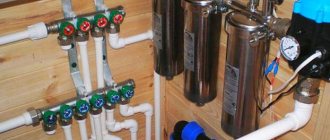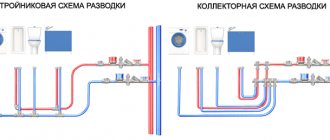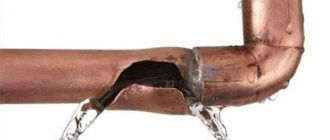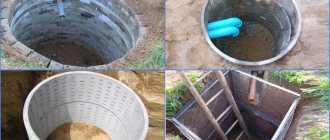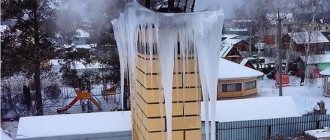Winter, frost and sun are not only a romantic mood and joy from snow-white surroundings. Frost can cause a lot of trouble in a private home - freezing of the water supply in a country house happens too often to ignore this possibility. What can be done to save the water supply system? First of all, don’t get upset or panic – you can find a way out of any situation. When a water pipe freezes, the problem can be solved in several ways.
Looking for a problem area
Before solving the problem of a frozen water supply, you need to find the place where the freeze is occurring. Remember: only those pipes freeze that are either located above the freezing depth or are poorly insulated. And if we are talking about a private house, then most likely these problem areas are well known to the owners.
Either the entire main line or some localized area may freeze - it is easy to determine if the flow of water has not stopped in part of the area (for example, there is water in a barn or garage, but not in the house).
Once the freezing location has been determined, you need to prepare it to fix the problem:
- excavate a localized area of frozen water supply;
- make deep holes-grooves when a large area freezes.
How to heat metal pipes?
Despite the widespread use of plastic pipes for water supply installations, many still prefer metal. To some extent, they are right - after all, even heating such a water supply is much easier than plastic:
- metal is not afraid of open fire - you can light a fire under the chimney;
- This material perfectly retains and distributes heat, so you can light a fire in one place and wait for it to thaw for a fairly long distance.
Please note: when heating a metal pipe, avoid exposing the threaded connections to the heat - they will then need to be repacked.
In addition to starting a fire near the frozen section of the pipe, you can try to defrost the pipeline using a hair dryer or blowtorch. These are not the most effective methods and can only be used when absolutely necessary. Be careful: when using a blowtorch, you should take fire safety precautions and use metal shields.
Electric current and frozen pipes
Metal is an excellent conductor of electricity, which can be used when the water supply freezes. You need to do the following:
- excavate a section of frozen water pipe;
- use a welding transformer - connect it to the pipe;
- apply electric current to the pipe.
When an electric current penetrates the metal, the latter becomes very hot, and the water in the pipe thaws. This method of thawing frozen water pipes made of metal pipes will take a lot of time - it will take several hours to thaw, but without your direct participation.
Causes of pipe freezing and ways to prevent them
The main reason for the appearance of ice in the water supply system is gross violations during its design or installation of the network without preliminary calculations. Avoiding freezing of communications and ensuring their uninterrupted functioning will allow strict adherence to the SNiP rules governing the following conditions for laying pipelines in the ground:
- the depth of pipe laying must be no less than the depth of soil freezing in the construction area;
- if the system is not used regularly in winter, water should be completely removed from the pipeline;
- it is necessary to take care of the insulation of the pipe at the entrance to the house.
In addition to violations of installation rules, the sewer can freeze due to overflow of the sewage pit or water leakage due to a faulty water supply system. An obstacle to the functioning of the utility network is the frequent blockages that occur when the pipe diameter is chosen incorrectly.
Freezing of a water supply system, whether under pressure or not, can only occur when the temperature of the surrounding soil is negative. In such a situation, defrosting the pipes without subsequent proper insulation is impractical, since they will freeze again when the soil cools.
You can prevent the appearance of ice in the sewer and water supply networks in conditions of constant soil freezing using an electric heating system. The principle of its operation is to use a special self-regulating cable, which is laid parallel to the pipes or wrapped around them.
Heating system using self-regulating cable
However, before eliminating the reasons why ice forms in the pipeline, the sewer and water pipes are actually defrosted, which can be done in several ways.
Heating cable against ice
The simplest and most affordable method of heating a frozen metal water pipe is to use a heating cable. They are sold in stores and are inexpensive, so they are available to everyone.
Assembling the heating cable is very easy - there are instructions for this.
But it is worth remembering some nuances in using a heating cable:
- There is no need to constantly turn on this device - it is enough to use it only at night and when severe frosts are predicted;
- be sure to ensure that the heating cable does not completely “go” to the pipes - leave a small fragment for control;
- the heating cable is capable of heating pipes up to 40 degrees;
- This device can be used to defrost water pipes and prevent further freezing for both plastic and metal water pipes.
Please note: it is advisable to use heating drops immediately when installing the pipeline. The main thing is to choose the right type of cable based on your goals (the cable can be simple or with a self-regulating system).
How to warm plastic pipes?
Traditional methods used to remove ice blockages in metal pipelines will not work on plastic pipes. You cannot light a fire near the pipe, use a welding machine, or try to insert a metal rod into the pipe (you will either not achieve any results at all or damage the pipeline). Only 2 methods are considered effective, which we will describe below.
Defrosting plastic pipes using a hair dryer
If the water supply is installed from plastic pipes, then under no circumstances should they be heated with an open fire - it is better to use a hair dryer. In this case, you should not count on a quick result, because... Plastic conducts heat very poorly.
If such a tool is not available, then you will have to resort to the old-fashioned method: the frozen pipe is wrapped in rags and boiling water is poured on them. It is necessary to achieve continuous shedding/warming of the frozen section of the pipe for 20-30 minutes.
Please note: before you start heating plastic pipes, you must open the tap - even slightly thawed water will find a way out under pressure.
Pouring hot water into pipes
If a plastic water pipe is frozen, the most effective way to solve the problem is to pour hot water inside. It is necessary to find the junction of two pipe sections closest to the place of freezing, unscrew them and insert a hollow tube into the area of ice accumulation (a gas or oxygen hose will do). You need to supply hot water through it - it will act directly on the ice and quickly defrost it.
The ice has thawed a little, but there is still no water coming out of the tap? This means you need to move further - push the tube or try to direct a stream of boiling water into the middle of the ice plug. After the water comes out of the tap, you can put the system back together. If the freezing area is located at the entrance to a house or garage, then you can insert a tube supplying boiling water into a section of the water supply that is located indoors.
You can also use an Esmarch mug to defrost water pipes. You will need a hydraulic level, steel wire with a diameter of 2-4 mm (we wrap it around the hydraulic level tube) and a medical device used for cleansing enemas (Esmarch's mug). The pipe defrosting diagram is shown below:
It will take a long time for the water supply to completely defrost: in an hour of work, you will free approximately 0.8 - 1.0 m of pipe from ice.
Defrosting
To begin with, it is necessary to say that there are several methods for performing such work. However, when answering the question of how to defrost a water pipe, it is worth distinguishing between the types of material from which it is made. The fact is that the approaches in some cases can be completely different.
The welding machine copes well with the task when working with metal pipes
Hardware
Usually, when answering the question of how to defrost a drainpipe made of metal or other similar systems, experts recommend using high-temperature sources. Fires are lit on the ground, where the route passes, and products traveling through the air are heated using blowtorches or special wires. You can also use welding machines, connecting their wires at the beginning and end of the frozen area.
If you do the work yourself, first of all, you need to open the taps so that the excess pressure generated when the water expands does not rupture the system. It is for this same reason that heating is carried out from the tap to the riser or main line. When sewerage is treated, the process begins, on the contrary, from the riser, moving towards the points of consumption.
A special heating element that is designed to defrost pipes by immersing them inside
Polyethylene materials
External heating does not have much effect on such structures, since plastic has very low thermal conductivity. At the same time, the operating instructions do not recommend using wire systems, since introducing metal inside can harm the plastic.
Building fires over highways can help, but is time-consuming
The most optimal method for such structures is a method that involves introducing hot water inside. To do this, use a tube or hose of a smaller diameter, which is inserted into the water supply until the plug forms, after which a warm saline solution is supplied. In this case, the thawed liquid will exit through the free space, which means the difference in diameters should be significant.
Installation inside the pipe through which hot water will be supplied
Recently, special kits for such work have begun to appear on sale. Their price is relatively low, and their ease of use allows them to be used even by novice craftsmen or people without experience.
For industrial use, special equipment is used, which is also used for cleaning
The ice has been removed - what to do next?
Whatever method you choose to defrost the water supply, you need to achieve the optimal result - get rid of ice. But even when this process is completed, you cannot relax - some repair work still needs to be done.
After the ice has disappeared and the water has flowed through the pipes, you need to drain about half a liter of water and turn off all the taps. Then, for 15-20 minutes, you will have to observe the sections of the excavated water supply pipes to see if water accumulates in the holes. If there is no such phenomenon, then the system remains intact even after its expansion by ice - you are lucky. If water is present, you will have to look for damage and replace the problem area.
Next, you need to wrap the pipes with thermal insulation material and bury them deeper - this is where the repair work is temporarily completed, everything else will be decided in the warm season.
How to insulate a water supply: preventive measures
You also need to take care to prevent the water supply from freezing again - winter is unlikely to end overnight. To do this you need to do the following:
- remember which areas of the water supply system are most susceptible to freezing and dig them out;
- wrap them with insulation or, in extreme cases, old rags - it doesn’t matter, the task is to insulate possibly problem areas;
- You need to lay a heating cord in places of possible freezing - this is sold in stores;
- try to ensure a constant, uninterrupted outflow of water, at least with minimal intensity.
Please note: if no one permanently lives in a private house during the winter, then drain the water from the entire system and turn off the taps.
Insulation of the water supply system must be carried out before winter arrives - this way it will be possible to avoid freezing of the pipes. To do this, you need to comply with the rules for the location of pipes in the ground - find out the depth of soil freezing in your region and, in the warm season, remodel the existing water supply system, or lay a new one in accordance with all the rules.
Preventive actions
Everyone knows that it is better to limit the amount of fatty and spicy foods than to subsequently be treated for gastritis or ulcers. The same can be said about the topic that we are discussing today. If the heating system is frozen, then first of all the problem must be eliminated. And when this is done, think about whether trouble can be prevented in the future. We assure you that this will cost much less than eliminating a full-scale accident at sub-zero temperatures.
Flushing
This is carried out strictly before the start of the heating season, or when the valve is closed. The procedure consists of pumping hot water through pipes until you get a completely clear liquid at the output. If the heating system has been turned off for a long time, you will additionally need a metal brush for rough mechanical cleaning. The process is quite lengthy and labor-intensive, but it can significantly reduce the likelihood of an accident during the heating season.
Installation of heating radiators
Why do this, you ask, if they seem to work fine? The fact is that over time, the batteries become clogged from the inside, the gaps through which the coolant circulates narrow, which leads to a decrease in the efficiency of the system and increases the risk of an accident. If the radiator is relatively “young” (3-5 years), then, of course, there is no point in spending money. But if he “remembers” the times of stagnation, the pioneers and May Day demonstrations, replacement is the best way out.
Installation of pipes with PPU insulation
The best option for those cases when the design of a heating system for a cottage is just underway, and the house itself has not yet been put into operation. Such pipes allow you to accurately determine the location of a leak or thinning of the shell, avoiding significant time and expense in searching for the problem area. Ideally, PPU-insulated pipes should be installed all the way from the distribution center to your home.
Leak test
The point is that the pressure in the newly filled and closed circuit must correspond to that which is available at the outlet several hours (days) later. If the readings taken by the pressure gauge are lower (i.e., for example, there was 1 atmosphere, but we have “only” 0.8), then it means there is a leak somewhere. Naturally, it is better to carry out such checks before the heating season begins.
Eliminating air jams
To do this, simply bleed the remaining air from the summer in the radiators (you will need a manual tap or automatic valve). The latter are located on the upper section of the subcircuit.
Antifreeze
If you are connected to a closed (individual) heating circuit, it is better to fill it not with ordinary water, but with a special liquid that never freezes. Propylene glycol, ethylene glycol, or a combination of both will work.
Additional pipe protection
The method is especially good for preventing freezing in rarely visited rooms (for example, in the basement). The anti-icing system, in essence, is “tying” a pipe with a special thermoresistive cable and then winding it with good insulation.
I would like to separately note one point. If the heating system in a private home is frozen, sometimes the culprit is... insufficient chimney draft. The connection here is the most direct. If the pipe is covered with combustion products, and coniferous trees are used for the firebox, the boiler often goes into an economical mode, which causes the temperature of the medium to decrease, which, in turn, increases the likelihood of freezing. Therefore, before the heating season, it is worth calling a specialist and cleaning out the dirt.
Recommendations for preventing water pipes from freezing
What can and should be done to prevent water pipes from freezing in winter? Only specialists can give a competent answer to this question. It is worth listening to their advice:
- Find the shut-off valve in the house in advance and report your finding to all adults living in the house.
- If you plan to move out of your country house for the winter, then drain the water from the system, turn off the taps and collect all the hoses.
- If all drainage systems on your site are located in a garage or shed, then the doors of these rooms should always be kept closed.
- If there are unprotected water pipes, you need to block any possible access of cold air to them - for example, plug all the holes with rags.
- It is not enough to insulate pipes in the ground; you need to take care of this in other places where the water supply runs - many people also have it in the attic.
- In case of severe frosts, you need to lay a heating cable along the pipes - ideally, this should be done along the entire length of the water supply, but it will also be enough to protect the “weakest” areas.
- In the winter season, when frosts are predicted, always keep the tap slightly open - let the water drain from the system slowly. If you see that the water has stopped flowing, this means that ice has appeared in the pipes - open the water more, it will force the ice that has already formed out of the pipes.
If you follow all the above recommendations, then no freezing will occur even in the most severe frosts.
Insulated pipes must be returned to their original position after the end of winter:
- firstly, you need to remove all heating devices and heat-insulating materials - overheating of the water supply is also harmful to the system;
- secondly, it is necessary to examine the condition of the water supply and drainage system - even with apparent prosperity, damage may be detected;
- thirdly, it is advisable to reconstruct the system and eliminate the possibility of water pipes freezing next winter.
Insulating the water supply is a direct path to joy from frost and sun. But if you haven’t taken care of this process in advance, you will have to resort to one of the methods recommended above to defrost the water supply.
( 73 votes, average: 4.75 out of 5)
How to make a metal gazebo with your own hands: step-by-step instructions
Do-it-yourself terrace for the house
Related Posts
Preparing the heating system for frost
There are situations when the radiators heat only half of the house. Or all the radiators are working, but they are barely warm, although the boiler is working at full capacity. To ensure that the heating network functions optimally throughout the heating season, perform several procedures before starting heating:
Flushing
Before the heating season, rinse the pipes with clean water under pressure (until completely clear water flows out). Flushing the pipes must be done if the heating system is drained for a long time - the inner surface intensively oxidizes and rusts without coolant. The longer the periods without liquid, the worse - you need to clean it mechanically, with a brush. Of course, this is a labor-intensive and routine process. But if your system did not drain and there were no leaks in it (it was not fed), then there is no need to flush it.
Checking the tightness of the system
When filling pipes with coolant, check the tightness of the system.
In a closed circuit, the tightness is checked using a pressure gauge. If the system is filled with water with a hydraulic pressure of 1 atm, then if there is no leak and air has been released from the circuit, the pressure gauge reading should remain 1 atm. If the pressure is lower, we look for a leak visually. Inspect all joints and welds. If no leaks are found in open areas, then it is likely that the pipe is leaking in a hidden place, under a screed or in the wall.
In an open system with natural circulation, we look for a coolant leak visually.
Checking ventilation and chimney ducts
When heating with solid fuel or gas ducts, to ensure sufficient draft for the boiler, inspect the supply ventilation and the chimney duct. The chimney of a solid fuel boiler must be cleaned at least once every year. If you use fuel made from coniferous wood, which has a high resin content, or your boiler often operates in an economical mode (which leads to increased formation of tar on the walls of the chimney), you need to clean the chimney additionally during the heating season.
Cleaning is done mechanically, with metal brushes or brushes.
Removing air pockets
After starting the heating, when pressure appears in the pipes, bleed the air accumulated in the radiators. Removal of air pockets is carried out using manual taps or through automatic valves, which are installed at the top point of each subcircuit.
Filling with coolant
In addition, if there is theoretically a possibility of turning off the coolant circulation, fill the entire heating circuit not with plain water, but with antifreeze (ethylene glycol, propylene glycol) or a mixture of them.
Heat balancing
To effectively distribute heat throughout the rooms, balance all batteries. Then you will ensure the required temperature in each individual room - warmer in bathrooms and cooler in hallways and bedrooms.

